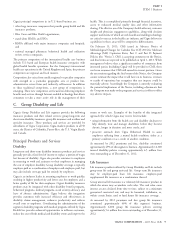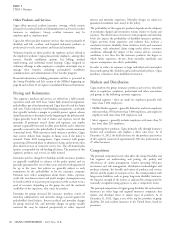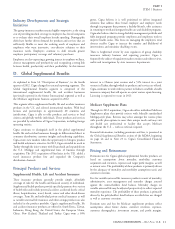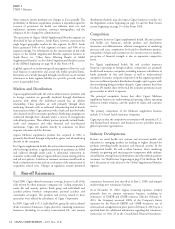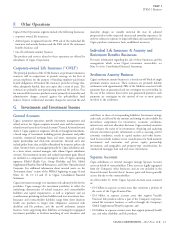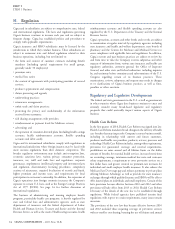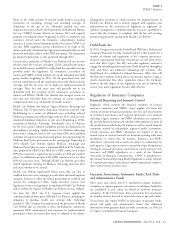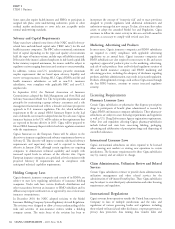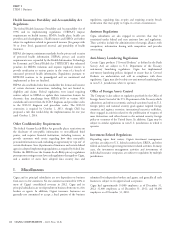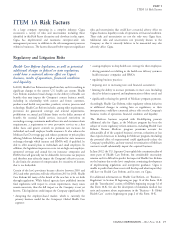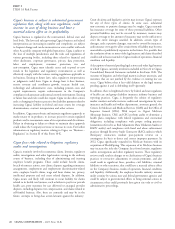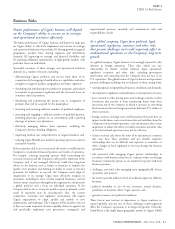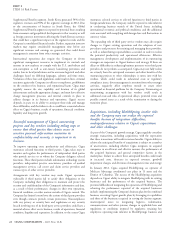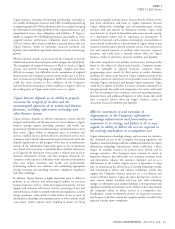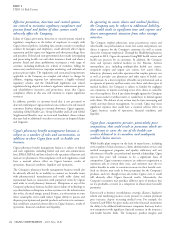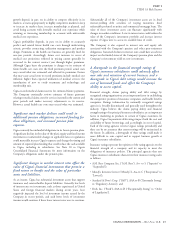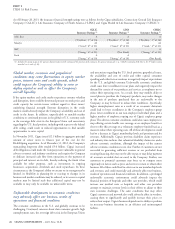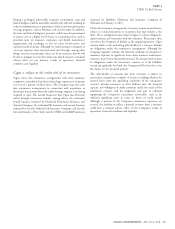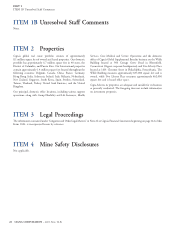Cigna 2012 Annual Report Download - page 40
Download and view the complete annual report
Please find page 40 of the 2012 Cigna annual report below. You can navigate through the pages in the report by either clicking on the pages listed below, or by using the keyword search tool below to find specific information within the annual report.
PART I
ITEM 1 Business
regulations, regulating data security and requiring security breach
Health Insurance Portability and Accountability Act
notification that may apply to Cigna in certain circumstances.
Regulations
The federal Health Insurance Portability and Accountability Act of
Antitrust Regulations
1996 and its implementing regulations (‘‘HIPAA’’) impose
requirements on health insurers, HMOs, health plans, health care Cigna subsidiaries are also engaged in activities that may be
providers and clearinghouses. Health insurers and HMOs are further scrutinized under federal and state antitrust laws and regulations.
subject to regulations related to guaranteed issuance (for groups with These activities include the administration of strategic alliances with
50 or fewer lives), guaranteed renewal, and portability of health competitors, information sharing with competitors and provider
insurance. contracting.
HIPAA also imposes minimum standards for the privacy and security
of protected health information. HIPAA’s privacy and security
Anti-Money Laundering Regulations
requirements were expanded by the Health Information Technology Certain Cigna products (‘‘Covered Products’’ as defined in the Bank
for Economic and Clinical Health Act (‘‘HITECH’’) that enhanced Secrecy Act) are subject to U.S. Department of the Treasury
penalties for HIPAA violations and requires regulated entities to anti-money laundering regulations. Cigna has implemented
provide notification to various parties in the event of a breach of anti-money laundering policies designed to ensure that its Covered
unsecured protected health information. Regulations pursuant to Products are underwritten and sold in compliance with these
HITECH continue to be promulgated and are monitored and regulations. Cigna may also be subject to anti-money laundering laws
implemented as they are finalized. in non-U.S. jurisdictions where it operates.
HIPAA also established rules that standardize the format and content
of certain electronic transactions, including, but not limited to,
Office of Foreign Assets Control
eligibility and claims. Federal regulations were issued requiring
entities subject to HIPAA to update their transaction formats for The Company is also subject to regulation put forth by the Office of
electronic data interchange from HIPAA 4010 to version 5010 Foreign Assets Control of the U.S. Department of the Treasury which
standards and convert from the ICD-9 diagnosis and procedure codes administers and enforces economic and trade sanctions based on U.S.
to the ICD-10 diagnosis and procedure codes. The ICD-10 foreign policy and national security goals against targeted foreign
conversion is required by October 1, 2013, though CMS has countries and regimes, terrorists, international narcotics traffickers,
proposed a rule that would delay the implementation for one year those engaged in activities related to the proliferation of weapons of
until October 1, 2014. mass destruction, and other threats to the national security, foreign
policy or economy of the United States. In addition, Cigna may be
subject to similar regulations in non-U.S. jurisdictions in which it
Other Confidentiality Requirements
operates.
The federal Gramm-Leach-Bliley Act generally places restrictions on
the disclosure of non-public information to non-affiliated third
Investment-Related Regulations
parties, and requires financial institutions, including insurers, to
provide customers with notice regarding how their non-public Depending upon their nature, Cigna’s investment management
personal information is used, including an opportunity to ‘‘opt out’’ of activities are subject to U.S. federal securities laws, ERISA, and other
certain disclosures. State departments of insurance and certain federal federal and state laws governing investment related activities. In many
agencies adopted implementing regulations as required by federal law. cases, the investment management activities and investments of
Neither the HIPAA nor the Gramm-Leach-Bliley privacy regulations individual insurance companies are subject to regulation by multiple
preempt more stringent state laws and regulations that apply to Cigna, jurisdictions.
and a number of states have adopted data security laws and
Miscellaneous
Cigna and its principal subsidiaries are not dependent on business submitted by independent brokers and agents, and generally all such
from one or a few customers. No one customer accounted for 10% or business is subject to its approval and acceptance.
more of Cigna’s consolidated revenues in 2012. Cigna and its Cigna had approximately 35,800 employees as of December 31,
principal subsidiaries are not dependent on business from one or a few 2012; 31,400 employees as of December 31, 2011; and 30,600
brokers or agents. In addition, Cigna’s insurance businesses are employees as of December 31, 2010.
generally not committed to accept a fixed portion of the business
18 CIGNA CORPORATION - 2012 Form 10-K
I.



